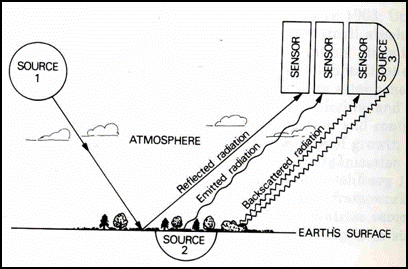Recent Comments
Archives
Categories
- No categories
Meta
2.2. Radiation and Remote Sensing
Sources
There are four main affects to the signal in a remote sensing system:
- The source of radiation
- Atmospheric effects
- Interaction with the target
- Sensor
There are three main sources of radiation as can be seen in the diagram:
- The sun (passive systems)
- The target itself (also a passive system)
- A source on the remote sensing platform (active system)

Reflection
Link the following systems into the classes of radiation source above:
- Light emissions of a volcano at night measured from a satellite
- Ultraviolet radiation measured over a land surface in the day
- Radar measurements taken from the space shuttle
Show Answer
Electromagnetic Radiation
The electomagnetic radiation spectrum varies by wavelength as explained in this animation
N/B: The animation below will not show on the webpage, but you can save/keep them on your computer and view them using the Adobe Flash Player 32 you downloaded earlier
Infrared and Visible Light
The reason our eyes see in three bands of visible light is that this is wavelength that the sun emits most energy in. Consequently, near infra red light emitted by the sun is powerful when compared to the energy the sun emits in the far infra red (far infra red is a longer wavelength) as the energy emitted begins to drop off.
An iron put in the fire glows with a red colour, if it is taken out of the fire it glows duller red and finally appears to emit no light at all. However, it is emitting still but as infra red radiation. The general rule is that the cooler the object, the longer the wavelength of light.
Reflection
Which of the two radiation types near infrared and far infrared do you think is associated with passive measurements of temperature at night and which is associated with measuring reflected light from the sun?
Show Answer
Microwaves
Microwave remote sensing can be active as with radar but can also be a passive system. One of its main advantages is that it is unaffected by clouds unlike visible light. Rainfall measurements shown on weather forecasts are often radar measurements of rainfall.